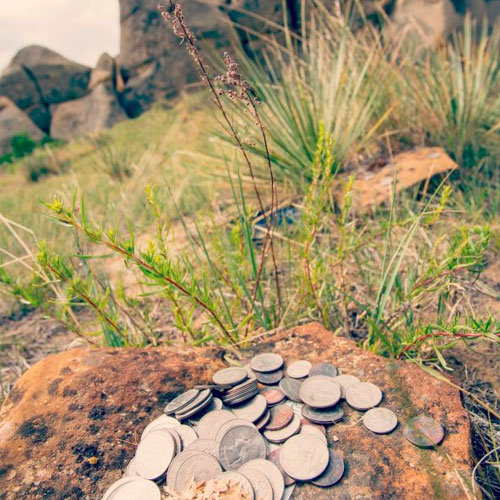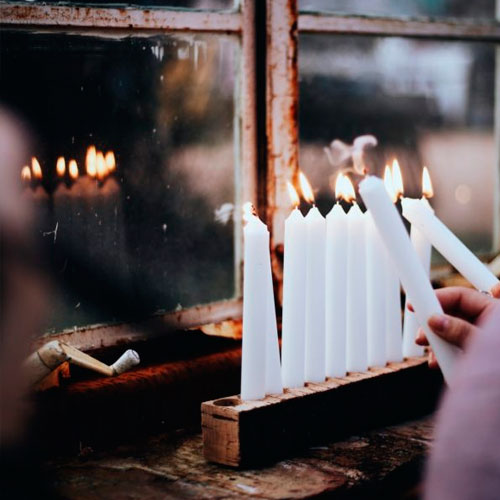
2020 is finally coming to an end. If this were any other year, it might find us booking flights to spend the holidays with our loved ones, exploring recipes, choosing presents, decorating our homes and pondering worthy New Year’s resolutions. But this isn’t any other year. This is the year that has shaken us to our core as individuals, as families, as communities, as a species.
Most of us will not be able to gather with our loved ones. Many of us are grieving fresh and devastating losses. It has been a time of great uncertainty, which will not magically end with the passing of the year. In this context, it may be tempting to ask if celebrating even makes sense at all.
As a first response, we might recall a story told by Holocaust survivor Elie Wiesel. The Jewish writer once shared how, while living as a prisoner in Auschwitz, he watched a fellow prisoner trade his daily ration of bread for some simple materials with which to piece together a makeshift menorah. Astonished at the sacrifice this man was making to observe the holidays, Wiesel asked the man, “Hanukkah in Auschwitz?” The man replied, “Especially in Auschwitz.”
What did Wiesel mean? Why was honoring a religious holiday so important in a place where everything that was familiar and sacred had been taken away? Precisely for that reason. When the usual scaffolding of our lives has been dismantled, when the comforting routines that sustain us have all but disappeared, then ritual and ceremony become vital nourishment, perhaps as never before.
What are rituals? There are as many definitions as scholars who study them and people who perform them. I can humbly offer my own: A ritual is an embodied symbolic act through which we render visible the invisible values, emotions, and insights that are most essential to us. For example, transcendent emotions such as love, awe, grief, gratitude, compassion, longing, forgiveness; values such as courage, kindness, humility, justice; the memory of those no longer with us; the lessons of our forefathers that we want to keep alive; our personal and collective milestones.
By embodying those inner realities and bringing them out into the world, in symbolic form, we give them a proper place in our lives, we allow ourselves to experience the emotions they evoke in us, and we share them with our communities
More specifically, here are some of the functions of ritual and ceremony in our lives:
- To create or strengthen bonds between people.
- To serve as reassurance and stability during a crisis.
- To forge a bridge between the past and the present and recall the elements of the founding myth.
- To distinguish kairos (soul time) from chronos (calendar time).
- To help heal body and soul.
- To recognize and usher in changes (rites of passage) in age, stage, and life cycles, while at the same time keeping participants connected to what is deep and unchanging.
- To consecrate new statuses, roles, and skills.
- To help us say goodbye.
- To engage in a form of adult play, with a serious purpose and meaning.
- To honor the sacred at the heart of everyday life.
We often associate ritual with time-honored traditions that are passed down across the generations. While it’s true that repeated gestures, symbols, and songs can be powerful and reassuring, we are beginning to understand that created or improvised rituals can be just as effective, and perhaps even more genuine, as they are adapted to the needs and sensibilities of those who perform them.
In fact, as scholars like Ronald Grimes and Sabina Magliocco point out, in the face of the growing secularization of Western societies (which has left us with a reduced repertoire of rituals), and the commercialization and appropriation of ritual occasions (which has impoverished those that remain), new rituals are emerging all around us to fill the gap. These newly minted rituals respond to the needs of current generations: They celebrate women’s autonomy and empowerment, protest racial discrimination, redefine families, redesign our ways of facing death. Most importantly, they help to usher forth social transformation.

Author Esther Perel tells of her experiences attending Burning Man, one such current day collective ritual. “[It] provided me with an immersive, secular ritual of remembrance I’d never known was possible. By day seven, the once empty temple formed a living memorial. In pictures, poems, objects, artwork, and other shreds of lives gone, thousands of people responded to their individual loss and our collective impermanence. I saw the entire drama of human experience laid bare and then burned away.”
All along in our private lives we have been enacting ceremonies, even though we might not have thought to call them by that name: Friday night dinners, book clubs, gratitude circles, contemplative walks, Crossfit, Soul Cycle and other fitness trends that have communal aspects. All of these spontaneous ritual gatherings have served somewhat the same purpose as ancient traditions (minus the religious underpinnings): they forge bonds, make friends out of strangers, help us quiet down and come back to ourselves, and instill a sense of connection and meaning — without preordained roles, scripts, or authority figures.
In his book The Power of Ritual, Casper Ter Kuile emphasizes the way such spontaneous rituals can help satisfy our deep and abiding need for community and belonging. But in order to get the full benefit from these activities, we must be intentional about them. And this brings us to one of the most important aspects of any ritual: intention. Whatever activity we are undertaking, we must stop and ask ourselves: What does this mean for me? What do I want it to mean? What do I wish to honor, celebrate, grieve, remember? Intention plus our full attention turns any activity that we deem worthy into a life-enhancing, sacred act.
Some authors also underscore the importance of repetition. Although repetition does help inscribe an act into our daily or weekly routine, proclaiming its importance, rituals can also be powerful as a one-time only event.
Lastly, the form and exact design of a ritual is, perhaps, the least important. In the chapter entitled “The Fire,” in my book Where Wonder Lives, I tell a short Hasidic tale about a village where a rabbi lived. Every time there was a hardship, the village people followed the rabbi to a certain tree in the forest and performed a certain ceremony. Many hard times ensued, and generation after generation disappeared. Finally, there came a time when the young people went out into the forest to perform the rite. But they couldn’t find the tree nor remember the songs or prayers. So they picked a tree, and they said the few words they remembered, the bits of song they could still sing, and that was enough.
So here we are, rounding the bend of this year, facing our own collective rite of passage. How are we to say goodbye to a year that has challenged our very ways of understanding the world, our role in it, and the future we want to build?
We can resort to ritual creativity, and find our own way to honor what each of us has learned as well as what we would like to carry forward into 2021. Here are some ideas:
- If this year drove home the importance of holding close those dearest to us, could we, perhaps, ritualize our intention to never again take each other for granted?
- If we are awed and moved by how Nature flourished during our absence these past months, could we commit ourselves to being better stewards by planting a tree, feeding the birds in our yard, cleaning up a nearby park, deciding on a weekly day off from driving?
- If we learned that distance is no barrier when there is genuine connection, can we organize a virtual festivity for the ages, remembering that, as Mary Oliver writes in her poem “The Messenger,” “all the ingredients are here”?
At first, we might feel awkward creating a ritual from scratch. But we can trust the ritual intelligence that inspired our ancestors (and that we have inherited, whether we know it or not), decide what it is we want to consecrate (make sacred) with our time and attention, and find the words and the gestures that feel natural for us. Some will work, some will need some fine tuning, but if they ring true to our hearts, we will be stepping on hallowed ground.
To nudge us along, here again is Mary Oliver, with her timeless advice: “Let me / keep my mind on what matters, / which is my work, // which is mostly standing still and learning to be / astonished.”
How will you give voice to your astonishment as you bid farewell to this year and welcome the next?
What images or symbols will you choose to honor it?
What will you make sacred today, and how?
